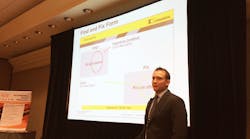SLC 2014: An Employee-Engagement Tool That’s Right in Kennametal’s ‘Sweet Spot’
If you were to view Kennametal Inc.’s find-and-fix safety program on a chart with a Y axis that represents effectiveness and an X axis that represents complexity, find-and-fix “is pretty much right in the sweet spot.”
“It has a very good balance of effectiveness and simplicity that enables people to really latch onto it,” said Jon Hansen, global health and safety manager for the Latrobe, Pa.-based manufacturer of metalworking tools and components.
During a breakout session at EHS Today’s 2014 Safety Leadership Conference in Indianapolis, Hansen said the name of the program – find-and-fix – speaks for itself.
“It is what it is: You find something and you fix it,” Hansen said.
Here’s how it works: When employees identify a safety hazard, they fill out a find-and-fix PowerPoint form. The template has an area for a picture and description of the hazardous condition (the “before”), and an area for a picture and description of the corrective action (the “after”).
When Kennametal launched find-and-fix in 2008 – as part of a companywide implementation of management-based safety – it was a tool for supervisors. However, when workers saw their supervisors using it, they asked for access to find-and-fix as well.
Since Kennametal made the tool available to all workers in 2009, the company has completed more than 24,000 find-and-fixes, according to Hansen.
“If an employee sees [a hazardous condition], the previous method was they would submit a maintenance ticket or push it off on somebody else,” Hansen said. “The nice thing about find-and-fix is it encourages employees to take ownership, think about the solution and play a part in implementing it. That ownership can drive a lot of engagement.”
Find-and-fix also fosters collaboration between workers and supervisors, Hansen noted. When Kennametal employees identify a potential find-and-fix issue, they first approach their supervisors to discuss the possible remedies and to determine whether the issue is an urgent one that should be addressed immediately through a maintenance work order or an EHS alert.
“In the areas where they work, [the employees] are the experts and they have a lot of great ideas,” Hansen said. “This gives them an avenue to get those ideas to their supervisors and their maintenance teams so they can execute on them.”
Because the find-and-fix program focuses on small, “low-cost to no-cost” safety issues, Hansen noted that the completion rate is above 98 percent.
Looking at the bigger picture, Hansen offered said there are four main factors behind the success of the find-and-fix program:
- It’s a straightforward and effective approach. It’s easy to understand and use.
- It’s part of a strong safety culture that starts with management support and emphasizes engagement at all levels. “It doesn’t exist in a vacuum,” Hansen said.
- It promotes employee ownership and recognition. At Kennametal plants in North America, workers receive reward tickets for submitting find-and-fixes. The tickets are redeemable for restaurant gift cards and other prizes.
- It leverages visual communication to “cut through the chatter.” Kennametal facilities post find-and-fixes on boards in common areas for all employees to see. At the corporate level, find-and-fix is a component on the EHS scorecard that goes out to senior managers every month.
One final note: Hansen said the find-and-fix program is mandatory. Supervisors must submit one find-and-fix per month, while employees are required to submit one per year.
“In the vast, vast, vast majority of cases, employees submit way more than one per year,” Hansen added.
